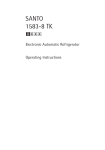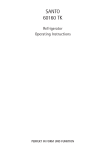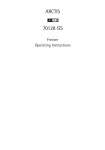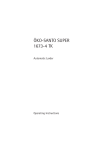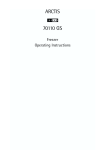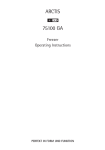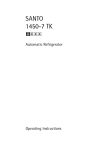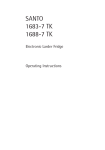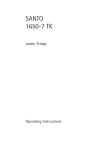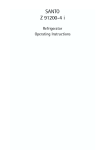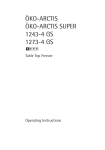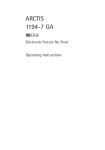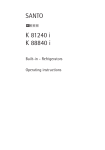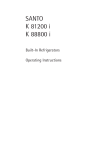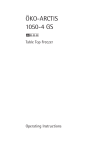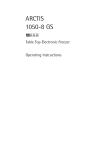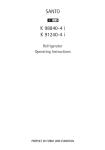Download Electrolux 70168 TK Refrigerator User Manual
Transcript
SANTO Table Top Refrigerator Operating instructions 70168 TK 70170 TK Dear customer, Before switching on your new appliance please read these operating instructions carefully. They contain important information for safe use, for installation and for care of the appliance. Please keep these operating instructions for future reference. Pass them on to possible new owners of the appliance. These operating instructions are for use with several technically comparable models with varying accessories. Please observe the notes which apply to your model. Notes which are important for your safety or for the proper functioning of the appliance are stressed with a warning triangle and/or with signal words (Warning!, Caution!, Important!). Please observe the following carefully. 1. This symbol guides you step by step in the operation of the appliance. 2. ..... Supplementary information regarding operation and practical applications of the appliance appear after this symbol. Tips and notes concerning economical and environmentally sound use of the appliance are marked with the cloverleaf. ☞ Explanations of the technical terminology used in the operating instructions can be found at the end in the section "Technical Terminology". The operating instructions contain instructions for the correction of possible malfunctions by the user in the section "What to do if ...". If these instructions should not be sufficient, contact your local Service Force Centre. Printed on paper manufactured with environmentally sound processes he who thinks ecologically acts accordingly... 2 Contents Important Safety Instructions . . . . . . . . . . . . . . . . . . . . . . . . . . . . . . . . . . . .4 Disposal . . . . . . . . . . . . . . . . . . . . . . . . . . . . . . . . . . . . . . . . . . . . . . . . . . . . .6 Appliance Packaging Information . . . . . . . . . . . . . . . . . . . . . . . . . . . . . . . . . .6 Disposal of old Appliances . . . . . . . . . . . . . . . . . . . . . . . . . . . . . . . . . . . . . . . .6 Remove transport packaging . . . . . . . . . . . . . . . . . . . . . . . . . . . . . . . . . . . . .7 Installation . . . . . . . . . . . . . . . . . . . . . . . . . . . . . . . . . . . . . . . . . . . . . . . . . . .7 Installation Location . . . . . . . . . . . . . . . . . . . . . . . . . . . . . . . . . . . . . . . . . . . . .7 Your refrigerator needs air . . . . . . . . . . . . . . . . . . . . . . . . . . . . . . . . . . . . . . . .8 Reversing the door . . . . . . . . . . . . . . . . . . . . . . . . . . . . . . . . . . . . . . . . . . . . . . .8 Plug socket . . . . . . . . . . . . . . . . . . . . . . . . . . . . . . . . . . . . . . . . . . . . . . . . . . . . .9 Electrical Connection . . . . . . . . . . . . . . . . . . . . . . . . . . . . . . . . . . . . . . . . . . . .10 Description of the Appliance . . . . . . . . . . . . . . . . . . . . . . . . . . . . . . . . . . . .11 View of the appliance . . . . . . . . . . . . . . . . . . . . . . . . . . . . . . . . . . . . . . . . . . . .11 Control panel / Temperature setting buttons . . . . . . . . . . . . . . . . . . . . . . . .12 Temperature display . . . . . . . . . . . . . . . . . . . . . . . . . . . . . . . . . . . . . . . . . . . . .13 Prior to Initial Start–Up . . . . . . . . . . . . . . . . . . . . . . . . . . . . . . . . . . . . . . .13 Starting up and temperature regulation . . . . . . . . . . . . . . . . . . . . . . . . . .13 COOLMATIC . . . . . . . . . . . . . . . . . . . . . . . . . . . . . . . . . . . . . . . . . . . . . . . . .14 Coolmatic Button . . . . . . . . . . . . . . . . . . . . . . . . . . . . . . . . . . . . . . . . . . . . . . .14 Malfunctions . . . . . . . . . . . . . . . . . . . . . . . . . . . . . . . . . . . . . . . . . . . . . . . .14 Switching off the appliance . . . . . . . . . . . . . . . . . . . . . . . . . . . . . . . . . . . .15 Interior Accessories . . . . . . . . . . . . . . . . . . . . . . . . . . . . . . . . . . . . . . . . . . .15 Storage shelves/glass shelves . . . . . . . . . . . . . . . . . . . . . . . . . . . . . . . . . . . . .15 Variable inner door . . . . . . . . . . . . . . . . . . . . . . . . . . . . . . . . . . . . . . . . . . . . . .16 Variable storage box / Bottle holder . . . . . . . . . . . . . . . . . . . . . . . . . . . . . .16 Correct storage . . . . . . . . . . . . . . . . . . . . . . . . . . . . . . . . . . . . . . . . . . . . . . .17 Defrosting . . . . . . . . . . . . . . . . . . . . . . . . . . . . . . . . . . . . . . . . . . . . . . . . . . .17 The fridge defrosts automatically . . . . . . . . . . . . . . . . . . . . . . . . . . . . . . . . . .17 Cleaning and Care . . . . . . . . . . . . . . . . . . . . . . . . . . . . . . . . . . . . . . . . . . . .18 Energy Saving Tips . . . . . . . . . . . . . . . . . . . . . . . . . . . . . . . . . . . . . . . . . . . .19 What to do if ... . . . . . . . . . . . . . . . . . . . . . . . . . . . . . . . . . . . . . . . . . . . . . .19 Correcting Malfunctions . . . . . . . . . . . . . . . . . . . . . . . . . . . . . . . . . . . . . . . . .19 Changing the light bulb . . . . . . . . . . . . . . . . . . . . . . . . . . . . . . . . . . . . . . . . . .21 Service and Spare Parts . . . . . . . . . . . . . . . . . . . . . . . . . . . . . . . . . . . . . . . .22 Customer Care Department . . . . . . . . . . . . . . . . . . . . . . . . . . . . . . . . . . . .22 Guarantee Conditions . . . . . . . . . . . . . . . . . . . . . . . . . . . . . . . . . . . . . . . . .23 Noises during Operation . . . . . . . . . . . . . . . . . . . . . . . . . . . . . . . . . . . . . . .24 Regulations, Standards, Guidelines . . . . . . . . . . . . . . . . . . . . . . . . . . . . . . .24 Technical terminology . . . . . . . . . . . . . . . . . . . . . . . . . . . . . . . . . . . . . . . . .25 3 Important Safety Instructions These warnings are provided in the interests of your safety. Ensure you fully understand them before installing or using the appliance. Your safety is of paramount importance. If you are unsure about the meaning of these warnings contact the Customer Care Department for assistance. Intended use • The refrigerator is intended for use in the home. It is suitable for cooling, freezing and storing of frozen food, as well as for making ice. If the appliance is used for purposes other than those intended or used incorrectly, no liability can be accepted by the manufacturer for any damage that may be caused. • Alterations or changes to the refrigerator are not permitted for reasons of safety. • If you use the refrigerator in a commercial environment or for purposes other than the cooling of foods, the manufacturer accepts no liability for any damages which may occur. Prior to initial start–up • Ensure that the appliance does not stand on the electrical supply cable. Important: if the supply cable is damaged, it must be replaced by authorised service or qualified personnel using a special cable of the same type. • Check the appliance for transport damage. Under no circumstance should a damaged appliance be plugged in. In the event of damage, please contact your supplier. Refrigerant The refrigerant isobutane (R600a) is contained within the refrigerant circuit of the appliance, a natural gas with a high level of environmental compatibility, which is nevertheless flammable. • Warning - During transportation and installation of the appliance, be certain that none of the components of the refrigerant circuit become damaged. • If the refrigerant circuit should become damaged: – avoid open flames and sources of ignition; – thoroughly ventilate the room in which the appliance is situated. Safety of children • Packaging (e.g. wraps, polystyrene) can be dangerous for children. There is a risk of suffocation! Keep packaging material away from children! 4 Important Safety Instructions • Please make old appliances unusable prior to disposal. Pull out the mains plug, cut off the mains cable, break or remove spring or bolt catches, if fitted. By doing this you ensure that children cannot lock themselves in the appliance when playing (there is risk of suffocation!) or get themselves into other dangerous situations. • Often children cannot recognise the hazards present in household appliances. It is therefore important that you ensure adequate supervision and never let children play with the appliance! Daily Operation • Containers with flammable gases or liquids can leak at low temperatures. There is a risk of an explosion! Do not store any containers with flammable materials such as spray cans, fire extinguisher refill cartridges etc in the refrigerator and/or freezer. • Warning - Do not operate any electrical appliances in the refrigerator and/or freezer (e.g. electric ice cream makers, mixers etc.). • Warning - In order not to impair the function of the appliance, never cover or obstruct the ventilation openings. • Warning - Do not damage the cooling circuit. • Warning - Placing frozen goods on the top of the appliance can lead to the accumulation of condensation in the cavity of the storage tray through contact with the cold. Electronic components are housed within this cavity. If condensation should drip onto these components, the appliance could be damaged by a short circuit. For this reason do not place frozen goods on top of the appliance. • Before cleaning the appliance, always switch off the appliance and unplug it, or pull the house fuse or switch off the circuit breaker. • When unplugging always pull the plug from the mains socket, do not pull on the cable. In case of malfunction • If a malfunction occurs on the appliance, please look first in the "What to do if ..." section of these instructions. If the information given there does not help, please do not perform any further repairs yourself. • This product should be serviced by an authorised engineer and only genuine spare parts should be used. • Under no circumstances should you attempt to repair the appliance yourself. Repairs carried out by inexperienced persons may cause injury or serious malfunctioning. Contact your local Service Force centre. 5 Disposal Appliance Packaging Information All materials are environmentally sound! They can be disposed of or burned at an incinerating plant without danger. About the materials: The plastics can be recycled and are identified as follows: >PE< for polyethylene, e.g. the outer covering and the bags in the interior. >PS< for polystyrene foam, e.g. the pads, which are all free of chlorofluorocarbon. The carton parts are made from recycled paper and should be disposed of at a waste-paper recycling collection location. Disposal of Old Appliances For environmental reasons, refrigeration appliances must be disposed of properly. This applies to your old appliance, and - at the end of its service life - for your new appliance as well. Warning! Before disposing of old appliances make them inoperable. Remove plug from mains, sever the power cable, remove or destroy any snap or latch closures. This ensures that children do not lock themselves inside the appliance (danger of suffocation!) or place themselves into other life-endangering situations. Disposal: • The appliance may not be disposed of with domestic waste or bulky refuse. • The refrigerant circuit, especially the heat exchanger at the back of the appliance, must not be damaged. • The symbol on the product or on its packaging indicates that this product may not be treated as household waste. Instead it shall be handed over to the applicable collection point for the recycling of electrical and electronic equipment. By ensuring this product is disposed of correctly, you will help prevent potential negative consequences for the environment and human health, which could otherwise be caused by inappropriate waste handling of this product. For more detailed information about recycling of this product, please contact your local city office, your household waste disposal service or the shop where you purchased the product. 6 Remove transport packaging The appliance and the interior fittings are protected for transport. 1. Pull off the adhesive tape on the left and right side of the door. 2. Remove all adhesive tape and packing pieces from the interior of the appliance. ☞ Installation Installation Location The appliance should be set up in a well ventilated, dry room. Energy use and efficient performance of the appliance is affected by the ambient temperature. The appliance should therefore – not be exposed to direct sunlight; – not be installed next to radiators, cookers or other sources of heat; – only be installed at a location whose ambient temperature corresponds to the climate classification, for which the appliance is designed. The climate classification can be found on the serial plate, which is located at the left on the inside of the appliance. The following table shows which ambient temperature is correct for each climate classification: Climate classification for an ambient temperature of SN +10 to +32 °C N +16 to +32 °C ST +18 to +38 °C T +18 to +43 °C If the refrigeration appliance is installed next to another refrigerator or freezer a clearance of 5 cm at the sides is required, in order to prevent the formation of condensation on the outside of the appliance. 7 Installation Your Refrigerator Needs Air For correct operation this appliance must be located in a dry atmosphere, away from heat sources, e.g. cookers, radiators, boilers and direct sunlight. You should also ensure that air can circulate freely around the back and the top of the cabinet. There should be 100mm (4”) between the top of the cabinet and any overhanging kitchen furniture. Alternatively allow 50mm (2”) between the top of the cabinet and any overhanging kitchen furniture and a gap of 25mm (1”) on either side of the appliance. If your refrigerator is installed under A/B a continuous worktop, an air outlet 10 200 cm2 opening of at least 200 cm2 and a ventilation grille (A/B) matching the C worktop design should be installed at 57 the rear of the worktop. 55 93The cut surfaces of the worktop (C) should be varnished to avoid swelling due to penetration of moisture. The appliance wall distance must be at least 30 mm and should be checked before the ventilation grille is inserted. Special accessories: A Ventilation grille, brown B Ventilation grille, white. AEG36 Reversing the door The side at which the door opens can be changed from the right side (as supplied) to the left side, if the installation site requires. Warning! When changing the side at which the door opens, the appliance must not be connected to the mains. Remove plug from the mains beforehand. 1 the appliance slightly towards the ☞1. Tilt rear and prop it securely. K 2. Unscrew the door hinge screws (K) AEG97 8 Installation and remove the hinge pin bracket (1). 3. Open the door a little way and take it out downwards. 4. Unscrew the upper pin (A) and screw it into place on the opposite side. 5. Fit the door into the upper pin (A) and close it. 6. Screw the hinge pin bracket (1) securely into place on the opposite side using the screws (K). 7. Unscrew the handle and refit it on the opposite side. Cover the holes left open with the plugs contained in the documentation pack. A 1 AEG98 AEG75 Plug socket The plug socket necessary for connection of your appliance to the electricity supply should be positioned so that it is possible to pull out the appliance plug. If your appliance is installed under a continuous worktop, the plug socket should be provided as shown. Alternatively a concealed spur socket 130 fitted with a 13 A fuse may be fitted. If the socket is not accessible once the appliance is built in, the electrical 300 installation must include suitable means of isolating the appliance from the mains (e.g. fuse, cut-out, current trip or similar with a minimum contact separation of 3 mm). The mains cable may only be changed by a qualified electrician or competent person. If your appliance needs repairing, please contact your local Service Force Centre. AEG44 9 Installation Electrical Connection Any electrical work required to install this appliance should be carried out by a qualified electrician or competent person. WARNING – THIS APPLIANCE MUST BE EARTHED The manufacturer declines any liability should these safety measures not be observed. 13 AMP Before switching on, make sure the electricity supply voltage is the same as that indicated on the appliance rating plate. The rating plate is inside, on the left. The appliance is supplied with a 13 amp plug fitted. In the event of having to change the fuse in the plug supplied, a 13 amp ASTA approved (BS 1362) GREEN & YELLOW 13 AMP. FUSE fuse must be used. Important The wires in the mains lead are coloured in accordance with the following code: BROWN Green and Yellow Earth BLUE CORD CLAMP Blue Neutral Brown Live As the colours of the wires in the mains lead of this appliance may not correspond with the coloured markings identifying the terminals in your plug, proceed as follows: 1.The wire coloured green and yellow must be connected to the terminal marked with the letter “E” or by the earth symbol or coloured green and yellow. 2.The wire coloured blue must be connected to the terminal marked “N” or coloured black. 3.The wire coloured brown must be connected to the terminal marked “L” or coloured red. 4.Upon completion there must be no cut, or stray strands of wire present and the cord clamp must be secure over the outer sheath. Warning! A cut-off plug inserted into a 13 amp socket is a serious safety (shock) hazard. Ensure that the cut-off plug is disposed of safely. D207 10 Description of the Appliance View of the appliance 8 3 9 1 2 3 4 5 6 7 8 9 Butter/cheese compartment Sliding shelf Door shelf Bottle shelf Salad bin Storage shelves Light switch Control panel Rating plate 11 Description of the appliance Control panel 1 2 3 4 5 6 7 Pilot light (green) ON/OFF switch Temperature setting buttons (for warmer temperatures) Temperature display Temperature setting buttons (for colder temperatures) COOLMATIC indicator light (yellow) Push button for COOLMATIC Temperature setting buttons The temperature is adjusted using the “+“ (WARMER) and “-“ (COLDER) buttons. These buttons are connected to the temperature display. • The temperature display is switched over from the display of the ACTUAL temperature (one light illuminated) to the display of the DESIRED temperature (one light flashing) by pressing one of the two buttons, “+“ or “-“. • With each further press of one of the two buttons, the DESIRED temperature is adjusted by one display field. • If neither button is pressed, the temperature display automatically switches back after a short period (approx. 5 sec.) to the display of the ACTUAL temperature. DESIRED temperature means: The temperature that is required in the refrigerator or freezer compartment, this can be adjusted to the temperatures shown in the display. The DESIRED temperature is indicated by a flashing light. ACTUAL temperature means: The temperature display indicates the temperature that is currently present in the refrigerator or freezer compartment. The ACTUAL temperature is indicated by a continuously illuminated light. 12 Temperature Display The temperature display can indicate several pieces of information: • During normal operation, the temperature currently present in the refrigerator or freezer compartment (ACTUAL temperature) is displayed, the corresponding light illuminates. • If the temperature in the refrigerator is warmer than the display range of the temperature display, all the lights in the temperature display are extinguished. • When the temperature is being adjusted, the temperature currently set flashes (DESIRED temperature). Prior to Initial Start–Up ☞ Please clean the appliance interior and all accessories prior to initial start-up (see section: “Cleaning and Care”). Starting up and temperature regulation the plug into the plug socket. When the refrigerator compart☞1. Insert ment door is opened, the internal lighting is switched on. 2. Press ON/OFF button. The green mains pilot indicator illuminates. 3. Press either the “+“ (WARMER) or “-“ (COLDER) button. The temperature display switches over and the DESIRED temperature currently set flashes on the temperature display. 4. Set the required temperature by pressing the “+“ (WARMER) or “-“ (COLDER) buttons (see section "Temperature setting buttons"). The temperature display will immediately show the changed setting. With each further press of one of the two buttons, the DESIRED temperature is adjusted by one display field. Adjustable temperature range: +2°C to +8°C. From a food safety point of view, +5 °C should be considered sufficiently cold for storing food in the fridge. 13 5. Once the required temperature has been set, after a short period (approx. 5 sec.) the temperature display will change and again indicate the current ACTUAL temperature inside the fridge. The display will change from flashing to continuous illumination. The compressor will start and then run automatically. Information! When the setting is changed, the compressor does not start immediately if automatic defrosting is currently taking place. As the storage temperature within the fridge is reached quickly you can store food immediately after switching on. COOLMATIC COOLMATIC Button The COOLMATIC function is suited for quick cooling of large quantities of goods in the refrigerator, e.g. drinks and salads for a party. COOLMATIC function is switched on by pressing the COOLMATIC ☞1. The button. The yellow light illuminates. 2. The COOLMATIC function now provides for intensive cooling. A DESIRED temperature of +2°C is automatically selected. The COOLMATIC function is ended automatically after a period of 6 hours. The originally selected DESIRED temperature is again valid. The temperature display shows the ACTUAL refrigerator temperature. 3. The COOLMATIC function can be ended manually at any time by pressing the COOLMATIC button again. The yellow light goes out. If the COOLMATIC function is switched on the temperature setting may not be changed. Malfunctions If the electronics in the appliance have detected a fault that prevents the ACTUAL temperature being measured, the temperature display will flash. The appliance will continue to function using a backup programme until your local Service Force engineer has repaired the appliance. 14 Switching off the appliance ☞ To switch off, press the ON/OFF button until the mains power light extinguishes. If the appliance is not going to be used for an extended period: 1. Remove all refrigerated packages. 2. Switch off the appliance by pressing the ON/OFF button until the mains power light extinguishes. 3. Remove the mains plug or switch off or disconnect the electricity supply. 4. Clean thoroughly (see section: “Cleaning and Care”). 5. Leave the door open to avoid the build up of odours. ☞ Interior Accessories Storage shelves/glass shelves ☞ Various glass or plastic storage shelves and wire trays are included with your appliance - different models have different combinations. You should always slide one of the full size glass storage shelves into the lowest set of guides, above the vegetable drawers, and keep it in this position. The height of the storage shelves can be adjusted: 1. To do this pull the storage shelf forward until it can be swivelled upwards or downwards and removed. 2. Please do the same in reverse to insert the shelf at a different height. ☞ ☞ D338 Your appliance is equipped with two half-size glass storage shelves. Storing tall items: Slide the front half of the Vario storage shelf in another level to the rear. By this means you will gain space to place tall items on the storage shelf below. 15 Interior Accessories Variable Inner Door The door compartments can be pulled up and removed, and inserted at other positions as needed. Variable Storage Box (not on all models, design differs depending on the model) Some models are equipped with a variable storage box which is fitted under a door shelf compartment and can be slid sideways. The box can be inserted under every door shelf compartment. 1. To change, lift the shelf compartment with the box upwards and out of the holders in the door and remove the retaining bracket out of the guide under the shelf compartment. 2. Please do the same in reverse to insert the shelf at a different height. ☞ The variable box can be hung from a storage shelf in the refrigerator compartment: 1. Pull the storage shelf forward until it can be tipped up or down and removed. 2. Hang the retaining bracket on the taper on the storage shelf and slide the storage shelf back into the guides. ☞ Bottle Holder Some models are equipped with a bottle holder in the bottle compartment. This is used to prevent individual bottles from falling over and can be slid sideways. 16 Correct storage For physical reasons, there are different temperature regions in the fridge. The coldest region is on the lowest storage shelf. Warmer regions are the top storage shelf, the vegetable drawer and the storage compartments on the door. The arrangement example shows at which places in the refrigerator suitable temperatures for various types of foods exist. Tip: Food in the fridge should always be covered or packaged, to prevent drying and tainting of other food. The following are suited for packaging: – Polyethylene airtight bags and wraps; – Plastic containers with lids; – Special plastic covers with elastic; – aluminium foil. Defrosting The fridge defrosts automatically The rear wall of the fridge covers with frost when the compressor is running, and defrosts when the compressor is off. The water from the thawing frost evaporates by itself. The water drainage hole must be cleaned regularly (see the section "Cleaning and Care"). 17 Cleaning and Care For hygienic reasons the appliance interior, including interior accessories, should be cleaned regularly. Warning! • The appliance may not be connected to the mains during cleaning. Danger of electrical shock! Before cleaning switch the appliance off and remove the plug from the mains, or switch off or turn out the circuit breaker or fuse. • Never clean the appliance with a steam cleaner. Moisture could accumulate in electrical components, danger of electrical shock! Hot vapours can lead to the damage of plastic parts. • The appliance must be dry before it is placed back into service. Important! • Ethereal oils and organic solvents can attack plastic parts, e.g. – lemon juice or the juice from orange peel; – butyric acid; – cleansers which contain acetic acid. Do not allow such substances to come into contact with appliance parts. • Do not use any abrasive cleansers. the food from the refrigerator. Store it in a cool place, well ☞1. Remove covered. 2. Switch the appliance off and remove the plug from the mains, or disconnect from the electricity supply. 3. Clean the appliance and the interior accessories with a cloth and lukewarm water with a little bicarbonate of soda added (5ml to 0,5 litres of water). 4. After cleaning wipe with fresh water and rub dry. 5. Check the water drain hole on the rear wall of the fridge. Clear a blocked drain hole with the aid of the green peg in the pack of accessories included with the appliance. 6. After everything is dry place appliance back into service. AEG48 18 Accumulation of dust at the condenser increases energy consumption. For this reason carefully clean the condenser at the back of the appliance once a year with a soft brush or a vacuum cleaner. Energy Saving Tips • Do not install the appliance near cookers, radiators or other sources of warmth. High ambient temperatures cause longer, more frequent operation of the compressor. • Ensure sufficient air circulation and exhaust at the appliance base and at the back wall of the appliance. Never cover air vent openings. • Do not place warm foods into the appliance. Allow warm foods to cool first. • Only leave door open as long as necessary. • Do not set temperature any colder than necessary. • Always keep the heat emitting condenser, the metal grille on the rear wall of your appliance clean. What to do if ... Correcting Malfunctions A malfunction may be caused by only a minor fault that you can rectify yourself using the following instructions. Do not perform any other work on the appliance if the following information does not provide assistance in your specific case. Important! Repairs to appliances may only be performed by competent service engineers. Improper repairs can give rise to significant hazards for the user. If your appliance needs repairing, please contact your specialist dealer or your local Service Force Centre. 19 What to do if ... Symptom Possible Cause Appliance is not switched on. Mains plug is not plugged Appliance does not work, in or is loose. green stand-by display and Fuse has blown or is defectemperature display are tive not lit. Switch on the appliance. Insert mains plug. Check fuse, replace if necessary. Socket is defective. Mains malfunctions are to be corrected by an electrician. All the lights in the temperature display are flashing. There is a malfunction. Inform your local Service Force Centre. Do not open the door of the appliance any more. Appliance cools too much. Temperature is set too cold. Press „+“ (WARMER) button. The food is too warm. Please look in the “Starting Temperature is not properup and Temperatur regulaly adjusted. tion” section. Door was open for an Open the door only as long extended period. as necessary. A large quantity of warm food was placed in the Press COOLMATIC button. appliance within the last 24 hours. The appliance is near a Please look in the heat source. “Installation location” section. Interior lighting does not work. Light bulb is defective. Please look in the “Changing the light bulb” section. Door seal is not air tight (possibly after reversing the door). Carefully warm the leaking sections of the door seal with a hair dryer (on a cool setting). At the same time shape the warmed door seal by hand such that it sits correctly. Heavy build up of frost, possibly also on the door seal. 20 Remedy What to do if ... Symptom Unusual noises. Possible Cause Remedy Appliance is not level. Readjust the feet. The appliance is touching the wall or other objects. Move the appliance slightly. The compressor does not start immediately after pressing the COOLMATIC button, or after changing the temperature setting. This is normal, no error has The compressor starts after occurred. a period of time. Water on the floor or on storage shelves. Water drain hole is blocked. See the “Cleaning and Care” section. Changing the light bulb Warning! There is a risk of electric shocks! Before changing the light bulb, switch off the appliance and unplug it, or disconnect from the mains supply. Light bulb data: 220-240 V, max. 15 W 1. To switch off, press the ON/OFF button until the mains power light extinguishes. 2. Unplug the mains plug. 3. To change the light bulb, undo the screw. 4. Press the light bulb cover as shown and slide it backwards. 5. Change the defective light bulb. 6. Refit the light bulb cover and the screw. 7. Put the refrigerator back into operation. ☞ 21 Service and Spare Parts In the event of your appliance requiring service, or if you wish to purchase spare parts, please contact your local Service Force Centre by telephoning: 0870 5 929929 Your telephone call will be automatically routed to the Service Force Centre covering your post code area. For address of your local Service Force Centre and further information about Service Force, please visit the website at www.serviceforce.co.uk. Before calling out an engineer, please ensure you have read details under the heading “Something Not Working”. When you contact the Service Force Centre you will need to give following details: 1.Your name, address and post code 2.Your telephone number 3.Clear and concise details of the fault 4.The model and serial number of the apliance. (found on the rating plate). 5.The purchase date Please note that a valid purchase receipt or guarantee documentation is required for in-guarantee service calls. Customer Care Department For general enquiries concerning your AEG-Electrolux appliance or for futher information on AEG-Electrolux products, please contact our Customer Care Department by letter or telephone at the address below or visit our website at www.aeg-electrolux.co.uk. Customer Care Department AEG-Electrolux Major Appliances Addington Way Luton Bedfordshire LU4 9QQ Tel: 08705 350 350* *calls to this number may be recorded for training purposes 22 GUARANTEE CONDITIONS Standard guarantee conditions We, AEG-Electrolux, undertake that if within 12 months of the date of the purchase this AEG-Electrolux appliance or any part thereof is proved to be defective by reason only of faulty workmanship or materials, we will, at our discretion repair or replace the same FREE OF CHARGE for labour, materials or carriage on condition that: · The appliance has been correctly installed and used only on the electricity or gas supply stated on the rating plate. · The appliance has been used for normal domestic purposes only, and in accordance with the manufacturer's operating and maintenance instructions. · The appliance has not been serviced, maintained, repaired, taken apart or tampered with by any person not authorised by us. · All service work under this guarantee must be undertaken by a Service Force Centre. Any appliance or defective part replaced shall become the Company's property. · This guarantee is in addition to your statutory and other legal rights. · Home visits are made between 8.30am and 5.30pm Monday to Friday. Visits may be available outside these hours in which case a premium will be charged. Exclusions This guarantee does not cover: · Damage or calls resulting from transportation, improper use or neglect, the replacement of any light bulbs or removable parts of glass or plastic. · Costs incurred for calls to put right an appliance which is improperly installed or calls to appliances outside the United Kingdom. · Appliances found to be in use within a commercial environment, plus those which are subject to rental agreements. · Products of AEG-Electrolux manufacture which are not marketed by AEG-Electrolux. European Guarantee If you should move to another country within Europe then your guarantee moves with you to your new home subject to the following qualifications: · The guarantee starts from the date you first purchased your product. · The guarantee is for the same period and to the same extent for labour and parts as exists in the new country of use for this brand or range of products. · This guarantee relates to you and cannot be transferred to another user. · Your new home is within the European Community (EC) or European Free Trade Area. · The product is installed and used in accordance with our instructions and is only used domestically, i.e. a normal household. · The product is installed taking into account regulations in your new country. Before you move please contact your nearest Customer Care centre, listed below, to give them details of your new home. They will then ensure that the local Service Organisation is aware of your move and able to look after you and your appliances. France Senlis +33 (0)3 44 62 29 29 Germany Nürnberg +49 (0)800 234 7378 Italy Pordenone +39 (0)800 117511 Sweden Stockholm +46 (0)8 672 53 60 UK Luton +44 (0) 8705 350 350 23 Noises during Operation The following noises are characteristic of refrigeration appliances: • Clicks Whenever the compressor switches on or off, a click can be heard. • Humming As soon as the compressor is in operation, you can hear it humming. • Bubbling/Splashing When refrigerant flows into thin tubes, you can hear bubbling or splashing noises. Even after the compressor has been switched off, this noise can be heard for a short time. Regulations, Standards, Guidelines This appliance was designed for household use and was manufactured in accordance with the appropriate standards. The necessary measures in accordance with appliance safety legislation regulations (GSG), accident prevention regulations for refrigeration appliances (VBG 20) and the regulations of the German Society of Electrical Engineers (VDE) were observed in the manufacture of this appliance. The refrigerant circuit has been checked for leaks. This appliance is in accordance with the following EU guidelines: – 73/23/EWG dated 19 February 1973 - low voltage guidelines. – 89/336/EWG dated 3 May 1989 (including guideline change notice 92/31/EWG) - EMV guideline 24 Technical terminology • Refrigerant Liquids that can be used to a generate a cooling effect are known as refrigerants. They have a relatively low boiling-point, indeed so low, that the warmth from the food stored in the fridge or freezer can cause the refrigerant to boil and vaporise. • Refrigerant Circuit Closed circulation system that contains the refrigerant. The refrigerant circuit comprises primarily of an evaporator, a compressor, a condenser and pipe work. • Evaporator The refrigerant is evaporated in the evaporator. Similar to all other liquids, refrigerant requires heat to evaporate. This heat is removed from the interior of the appliance, as a result the interior is cooled. The evaporator is therefore located inside the appliance or placed in foam immediately behind the inner wall and thus not visible. • Compressor The compressor looks like a small drum. It is driven by a built-in electric motor and is mounted on the base of the appliance at the rear. The task of the compressor is to draw in vaporised refrigerant from the evaporator, to compress it, and to pass it on to the condenser. • Condenser The condenser normally has the form of a grid. The refrigerant compressed in the compressor is liquefied in the condenser. During this process, heat is released to the surrounding air at the surface of the condenser. The condenser is mounted on the base of the appliance. 25 AEG Hausgeräte GmbH Postfach 1036 D-90327 Nürnberg http://www.aeg.hausgeraete.de © Electrolux plc 2005 2222 661-74 -00- 0306 Subject to change without notice




























